Red Necked Keelback – Venomous – Dangerous

(Page Updated: 1 May 2022)
Rhabdophis subminiatus (Red-Necked Keelback Snake)
Thai: (ngoo lay sab ko dang)
Length: Up to 100 cm (1 meters). I’ve never seen one close to 1 meter in length.
Range: Thailand and southeast Asia.
Notes: These snakes are commonly found near water, lakes, ponds, and in gardens. Recently a friend had one in his swimming pool in Krabi town, southern Thailand.
Active Time? Daylight hours. I’ve found them sleeping around 1 foot off the ground in bushes.
Food: Frogs, poisonous toads, and fish. I have not seen them eat anything but frogs and toads.
Defensive Behavior: Spread out the neck slightly to make themselves appear bigger. Not as dramatic as a cobra. Lift their head and neck off the ground 4-5 inches.
Some snakes of this species, and others in the genus Rhabdophis, have displayed a rather unique defensive behavior of exposing the back of their neck and secreting poison from their nuchal glands. This is not all that common unless very provoked.
One researcher, Kevin Messenger, claims that the R. subminiatus helleri he caught in Hong Kong actually sprayed a mist of the poison into the air from the back of the neck. Quite amazing, if true, right? Obviously more study is needed into the secret life of this fascinating snake. Other snakes in Rhabdophis genus with nuchal glands: R. nuchalis, R. tigrinus, R. nigrocinctus, and R. chrysargos (in Thailand).
Here is an image of the snake expressing poison from the nuchal glands.
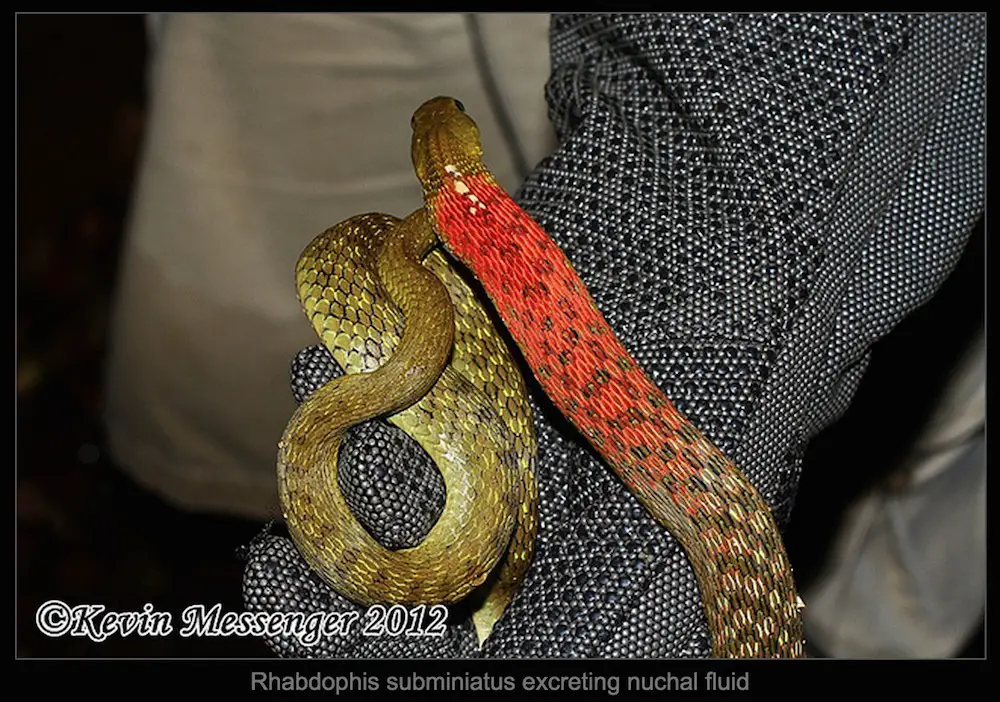
Here is the description in a scientific journal about Kevin’s encounter (link changed).
Venom Toxicity: LD50 is 1.29 mg/kg for intravenous injection (source). That is about the same rating as the very deadly “Banded Krait (Bungarus fasciatus)”. It was previously thought these snakes were harmless. Some kept them as pets and were bitten. In one case the snake was left to bite for two entire minutes before removing it from a finger.
Serious complications resulted requiring hospitalization and intensive care. Click for article. These snakes are rear-fanged and need to bite and hold on, or, repeatedly bite to have any effect on humans. Once they do either – there is the possibility of severe problems including renal failure and death. Recently a small boy of 12 years old was bitten by one he was keeping as a pet in Phuket, Thailand and he is currently being treated (11/5/10). Be very careful not be be bitten by these snakes. There is NO ANTIVENIN available yet for these snakes in Thailand. Scroll down for information about antivenin manufactured in Japan that may have some positive effect.
Another study in Japan ranked the venom as having an LD50 of 1.25 mg/kg for intravenous injection. (Japan Snake Institute, Hon-machi, Yabuzuka, Nitta-gun, Gunma-ken, Japan) V.1- 1969- Volume(issue)
In Japan they make limited amounts of antivenin, but it is specifically for their in-country use.
One WHO (World Health Organization) publication about the management of venomous snake bites in Southeast Asia mentions the antivenin for Rhabdophis tigrinus in Japan as having some effect on the venom of R. subminiatus. I am not sure if this is strictly for R. subminiatus found in Japan, or not. Worth a try though if you can get them to send you some antivenin. Otherwise, there is no other option – there is no monovalent antivenin specifically for R. subminiatus.
Japan Snake Institute
Nihon Hebizoku Gakujutsu Kenkyujo
3318 Yunoiri Yabuzuka
Yabuzukahonmachi Nittagun Gunmaken 379-2301
Tel 0277 785193 Fax 0277 785520
Snake-c@sunfield.ne.jp
www.sunfield.ne.jp/~snake-c/
Yamakagashi (Rhabdophis tigrinus) antivenom. Also effective against rednecked keelback (R. subminiatus venom)
Update: The 12 year old boy bitten by the Rhabdophis subminiatus was treated for 2 weeks of intensive care, and released. He was bitten multiple times, the 2nd bite lasting over 20 seconds.
Offspring: I had a juvenile red-necked keelback I’ve taken photos and videos of and released into the wild. I cannot find anything much about offspring. Recently (mid-June) I found a DOR juvenile very recently hatched, so like most snakes in Thailand the time around June is when they are hatching out. The coloration of the juvenile is quite different from adults as you can see in the photo and video below.
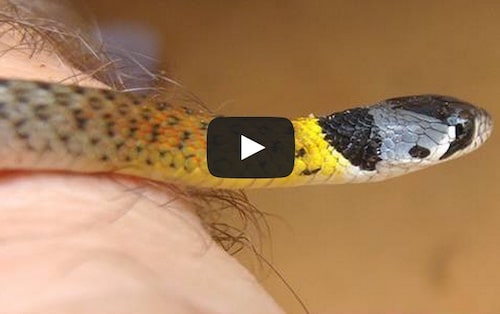
Notes: These snakes can inflict a deadly bite when they are allowed to bite for longer than a couple of seconds. I know personally of two instances where a child was bitten for well over 20 seconds, and a man was bitten for about a minute. Neither wanted to hurt the snake to remove it forcibly, and both spent over a week in intensive care, with the possibility of renal failure and death. Do not play with these snakes. If you have one, do not free-handle it. Treat it like you would a pit viper or a cobra. The LD50 on this snake for intravenous was stated to be 1.29 mg/kg. That is VERY venomous.
As a precaution, any snake in the Rhabdophis genus should be treated with extreme caution. In Thailand we also have the diurnal Rhabdophis nigrocinctus, and Rhabdophis chrysargos, both of which may be able to inflict a medically significant bite if given the opportunity.
Red-necked Keelback Scientific Classification
Kingdom: Animalia
Phylum: Chordata
Class: Reptilia
Order: Squamata
Suborder: Serpentes
Family: Colubridae
Genus: Rhabdophis
Species: Rhabdophis subminiatus

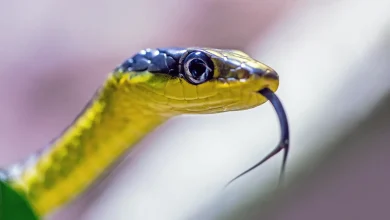
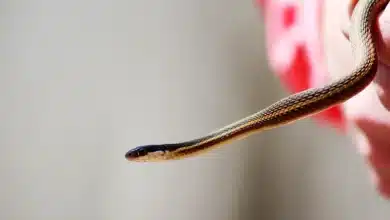
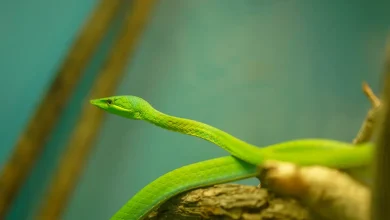
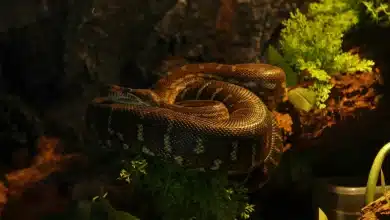
I saw one of these in the road on koh lanta with cars driving past only just missing it.. being an animal lover I couldn’t bear the possibility of it being squashed so picked it up halfway along its body and put it in a bush.it was docile and didn’t react when I first tried and failed to pick it up with a stick so I used my hands.
I decided to look it up and came across your website only to learn it’s a pretty venemous snake!!
I’m still glad to have saved it but won’t be doing that again.
lots of venomous snakes in Thailand – please don’t pick up snakes you don’t know…
Hi Vern,
Been in Phon Phisai for 3 years now with my partner. Not seen the Redneck Keelback but had a Keelback in the doorway last year, locals killed it and took it away. Mostly see the bronzeback and golden tree snake here, they look pretty smart. Have heard of 2, so far, cobra ( type unknown ) that have been killed by locals outside our house. They would have come from the paddy fields, also been told of kraits ( yellow / black ) in / near the river about 100 metres at the rear of the house. Have also had two oriental rat snakes in the gardens, one was gone pretty swiftly but the other which was at least 2 metres in length, wrist thick was killed and been told was to be cooked ( joking / not joking I have no idea ). I have some pictures in my website, its being updated when the heat eases up a bit and I don’t drip buckets updating. I will let you have it when I have updated. Will also keep you posted of anything I hear about in the village. Oh have seen 1 water monitor on the same stretch of water.
Cheers
Thanks for the update Ivor – lots of snakes around up there. Some (all?) of the rat snakes are given some level of protection from being killed in Thailand, and yet locals kill them the most because they’re plentiful and easily seen. They make lahp or other meals from it. Probably they weren’t joking about eating it, it’s frequently done. Locals have no idea about the illegality of it, and they’d probably just laugh at it anyway. Who is going to catch them killing and eating the snakes? They’ve been doing it since day 1 – won’t stop now. Thailand needs a site in Thai language that details what is legal, what isn’t, what is dangerous, what isn’t. There is a forum I know of, but not sure it comes up in Google searches.
I still haven’t seen a Banded Krait (B. fasciatus) in the wild. Hope to see one soon.
Anyway – thanks again – cheers!
Lots of red-necked keelbacks here in Sai Kung district, Hong Kong.
I just watched one swim across a rockpool here in the Sai Kung country park (thus i am here now, on your website). It was about 80-90cm.
I see them quite regularly whilst hiking to/from my house here in Sai Kung.
Likewise i have seen (and almost stepped on) bamboo (pit) vipers, banded krait (once only), many-banded kraits, Chinese cobras, rat snakes, Taiwan kukri snakes… Apparently, there are king cobras here too – but I’ve never seen one.
Appreciate your website.
Cheers!
Thanks Baz! Yeah, a lot of snakes in Hong Kong – surprising to me because it is so built-up. Taiwan also – so many snakes!
We had a red neck keelback in the garden the other day. Sadly the wife despatched it before I could stop her. I haven’t told her quite how venomous they can be, but I have pointed out they eat the frogs and toads that keep her awake and are unlikely to bite unless they feel threatened. I also said to stop the snake biting, even if the snake is damaged in the process. I think that advice was superfluous!
The other snake that didn’t survive the wife was a kukri snake. Unfortunately they bear a superficial resemblance to Malayan Pit Vipers, which are annoyingly common around here. They are dangerous more because they don’t move and are well camouflaged. Specially for a blind bastard like me!
Thanks for your informative site!